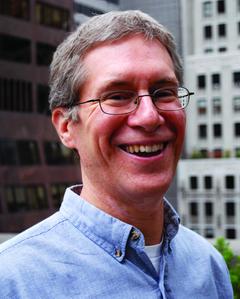
|
|
| photo: Michelle Corpora | |
Kevin Henkes pitched his first picture book to Susan Hirschman of Greenwillow Books at age 19 and was off to the races. He received the 2005 Caldecott Medal for Kitten's First Full Moon, Caldecott Honors for Owen and Waiting, Newbery Honors for his novels Olive's Ocean and The Year of Billy Miller, and Geisel Honors for Penny and Her Marble and for Waiting. Henkes lives in Madison, Wis., with his wife and fellow illustrator, Laura Dronzek, and has two college-aged children. Shelf Awareness talked with him on the phone, mostly about his picture book called Egg (Greenwillow, January 3, 2017).
Egg is your 50th published children's book. Can you get your head around that?
No, I cannot! But I have a list on my bulletin board of every book that I've done. After I finish a book I type the title on my typewriter... and I've had that same piece of paper since 1981, and there they all are. So I know that it's true, but it is hard to believe.
I like that practice.
It's kind of fun, and it's great to have easy access to all of them in order. I looked at the list recently, and there are only two years since 1981 that I didn't publish a book.
Do you ever just line up all your books end to end on your studio floor and walk among them?
I have not. For one thing, I'd have to vacuum.
When we talked last year about your now-award-winning picture book Waiting, you said, "Waiting is definitely on my mind.... There's another picture book I'm illustrating called Egg and there is a lot of waiting in that, it's mentioned maybe 17 times." Tell us about all this waiting.
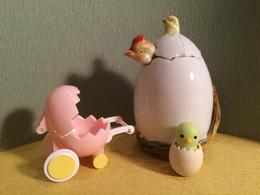
|
|
|
The Egg inspirations |
|
Well, I have been thinking about waiting. And that led me to think about eggs. In my studio I collect things that I like on a shelf. Not long ago, three little things caught my attention. One of the things is a china egg that Susan [Hirschman] gave me many years ago. I also saved a plastic egg--a little baby buggy--that was my daughter Clara's. I kept it because it seemed to scream, "There's a story here somewhere!" I also have a little egg that's an eraser that I bought when I needed to draw erasers for one of the Billy Miller illustrations.
I think eggs are interesting because when I look at an egg I think of transformation--and expectation--and with this book I was thinking of misconceptions. Eggs are also about concealment and containment.
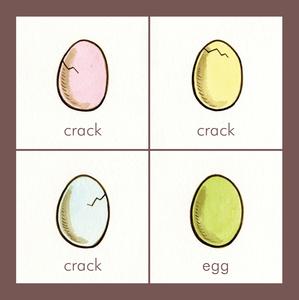
|
|
And the story just hatched one day?
I think the main force behind Egg is that I've been intrigued by wordless books for my whole career, but I'm so in love with type that I've never really wanted to make one. But when I decided, again, that I might like to try it, I couldn't! So I asked myself, "Can I tell a story by using single words only, no traditional sentences?" That's how it really began.
Tell us how you decided to format Egg in panels. Is this a "preschooler's first graphic novel?" How did you use boxes and grids in your storytelling?
As I was working on it, I did think of it as a graphic novel for preschoolers. I really do love visual storytelling with no words. Several of my books have that in them. In A Weekend with Wendell, Wendell and Sophie are playing with the hose and they become friends and a rainbow forms... a lot of that is told just in the pictures. And in Julius, the Baby of the World, when Lilly's in the uncooperative chair, it wordlessly shows the passage of time.
And you are also playing around with comic timing, right?
Yes. Absolutely. In the opening series of Egg, the green egg is down in the lower-right quadrant, and just labeled "egg," [while the other egg images later say "crack" and "surprise!"] because it's not hatching like all the others. I think of that as being wildly funny.
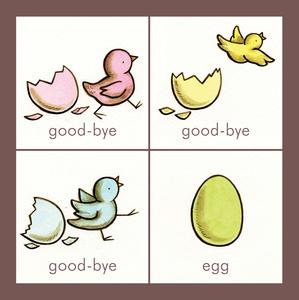
|
|
It is funny. I like that you say "wildly funny."
I did think of it as wildly funny! Who knows? Maybe, maybe not. Did you think it was wildly funny?
Maybe I'd say "pretty funny." Kevin Henkes-funny, right?
Yes. Exactly.
Did you read comics as a kid?
I did. I read a lot, and they were part of what I read. I didn't by any means only read comics. I preferred picture books and novels, and I loved novels the most.
Back to Egg. Which came first, the chicken... or the alligator?
I didn't have the reptilian figure in the beginning at all. I knew one egg would be late to hatch, but I didn't know what it would be. I even toyed with the idea of it being a chocolate egg. I thought of lots of different things and all of a sudden it came to me, in the way that things do.
And then, when the baby alligator scares off the birds, it became a study in cross-species tolerance?
Ha! I was thinking of Egg as a gently surreal little movie-musical. I imagined different music for the pink, yellow and blue birds. The pink bird, even on the page where it says "good-bye," seems to be walking with purpose. And it points several times. It's bossy. The yellow one on the first page is flying when the other two are walking, and coming from far away, so I think of the yellow one as being more adventurous. The sun turning into an egg at the end could be open-ended and a little surreal, but it fit perfectly into the idea of what I said before about eggs and transformation and expectation... a nice little ending for that movie-musical.
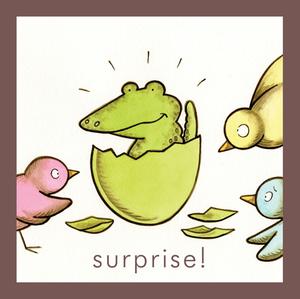
|
|
I am clearly going to have to read Egg again with all this in mind.
I didn't want it to be overwhelmed with "extras," but I wanted something there to give it texture.
Especially for the adults who are going to be reading it 150 times to their children.
Yes, I imagined this book as interactive, something one might share with a child on one's lap.
You keep trying out new styles. Is there one style you consider your "main style" and another that you consider "branching out"? Or is it all equally "you"?
I think it's all equally me. People have said that some of my books are bolder and the line is thicker compared to the mouse books like Lilly's Purple Plastic Purse. I might be using a brush rather than a crow-quill pen but I tend to make my marks the way I make my marks. Every now and again I'll do something very, very different, but I tend to go back to the way I always do things.
So, maybe not Kandinsky next?
Probably not, but you never know. It's fun to limit myself. With Egg, I decided early on that I would not have backgrounds at all. And I limited myself to four colors... I guess five. I really like limiting myself. It opens up a world of possibilities, which seems ironic but true, too.
Like poetry.
Yes. To limit yourself in how you use words--and how many words--and still come up with something that makes sense.
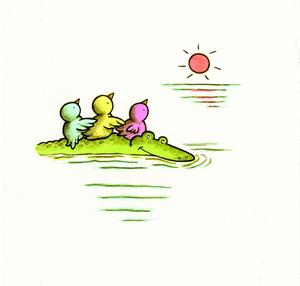 |
|
I remember you saying that novels seem easy when you're working on a picture book and picture books seem easy when you're working on a novel.
That's so funny because throughout most of A Parade of Elephants I was thinking, "I just want to do a novel, I just want to do a novel."
A Parade of Elephants?
Yes! It's a very young picture book. There are sentences this time, though. It's about five elephants and what happens to them on a typical day, but it's very, very simple. I've wanted to do an elephant book for years and years and years. And this I think came about because of the little elephant in Waiting.
You need a new one since you killed off that elephant.
[Nervous laughter.] Yeah. Yes.
How is it that you know so well how to tell stories to young people?
When I'm working on a book I don't particularly think about a child reading it. I become lost to whatever it is I'm working on. I want to make a book that is rich and thickly textured and deeply felt, but I do want it to be for a child and I don't want it to be overly ironic. It seems like a lot of children's books are ironic, but it isn't what I'm drawn to.
My niece has two young kids. They don't seem to be ironic at all. Their sense of imagination is incredible to watch, and they are so full of joy, and they are so good at pretending. They marvel at a leaf or a rock and start making up stories for things like a leaf or a rock. Watching them confirmed for me what I think I've known from watching my own kids. It confirms what makes me feel good about how I approach books, and it explains the kinds of books that I do.

